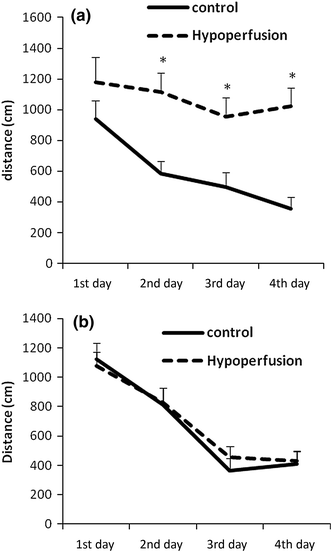The effects of two-stage carotid occlusion on spatial memory and pro-inflammatory markers in the hippocampus of rats
- PMID: 27470129
- PMCID: PMC10717598
- DOI: 10.1007/s12576-016-0474-z
The effects of two-stage carotid occlusion on spatial memory and pro-inflammatory markers in the hippocampus of rats
Abstract
The purpose of this study was to evaluate the effects of cerebral hypoperfusion on cognitive ability, TNFα, IL1β and PGE2 levels in both hippocampi in a modified two-vessel occlusion model. Both common carotid arteries of adult male Wistar rats were permanently occluded with an interval of 1 week between occlusions. Learning and memory were significantly decreased after 1 month. This reduction was not significant after 2 months, which may be attributed to blood flow compensation. The TNFα level was significantly increased after 3 h and 1 day. IL1β was significantly increased after 1 day. After a week there was no significant difference in pro-inflammatory levels. Furthermore, there was no difference between right and left hippocampi. It is possible that TNFα and IL1β elevation initiates pathologic processes that contribute to memory impairment.
Keywords: Cerebral hypoperfusion; Hippocampus; Inflammation; Interleukins; Spatial memory.
Conflict of interest statement
The authors declare that they have no conflict of interest.
Figures







Similar articles
-
Cerebral hypoperfusion yields capillary damage in the hippocampal CA1 area that correlates with spatial memory impairment.Neuroscience. 1999;91(1):203-10. doi: 10.1016/s0306-4522(98)00659-9. Neuroscience. 1999. PMID: 10336071
-
A high calorie diet causes memory loss, metabolic syndrome and oxidative stress into hippocampus and temporal cortex of rats.Synapse. 2015 Sep;69(9):421-33. doi: 10.1002/syn.21832. Epub 2015 Jun 30. Synapse. 2015. PMID: 26073877
-
Chronic nanocurcumin treatment ameliorates pain-related behavior, improves spatial memory, and reduces hippocampal levels of IL-1β and TNFα in the chronic constriction injury model of neuropathic pain.Psychopharmacology (Berl). 2021 Mar;238(3):877-886. doi: 10.1007/s00213-020-05739-x. Epub 2021 Jan 6. Psychopharmacology (Berl). 2021. PMID: 33404738
-
Roflumilast promotes memory recovery and attenuates white matter injury in aged rats subjected to chronic cerebral hypoperfusion.Neuropharmacology. 2018 Aug;138:360-370. doi: 10.1016/j.neuropharm.2018.06.019. Epub 2018 Jun 19. Neuropharmacology. 2018. PMID: 29933009
-
Profound but transient deficits in learning and memory after global ischemia using a novel water maze test.Behav Brain Res. 2006 Jan 30;166(2):204-10. doi: 10.1016/j.bbr.2005.07.016. Epub 2005 Sep 12. Behav Brain Res. 2006. PMID: 16159675
Cited by
-
Metabolic Syndrome and Vascular-Associated Cognitive Impairment: a Focus on Preclinical Investigations.Curr Diab Rep. 2022 Aug;22(8):333-340. doi: 10.1007/s11892-022-01475-y. Epub 2022 Jun 23. Curr Diab Rep. 2022. PMID: 35737273 Free PMC article. Review.
-
Hemodynamic changes and neuronal damage detected by 9.4 T MRI in rats with chronic cerebral ischemia and cognitive impairment.Brain Behav. 2022 Jul;12(7):e2642. doi: 10.1002/brb3.2642. Epub 2022 Jun 10. Brain Behav. 2022. PMID: 35687797 Free PMC article.
-
Nigella sativa and thymoquinone attenuate oxidative stress and cognitive impairment following cerebral hypoperfusion in rats.Metab Brain Dis. 2019 Aug;34(4):1001-1010. doi: 10.1007/s11011-019-00394-4. Epub 2019 Apr 23. Metab Brain Dis. 2019. PMID: 31016464
-
Effects of Lipoxin A4 Pretreatment on Cognitive Function of Aged Rats after Global Cerebral Ischemia Reperfusion.Curr Med Sci. 2018 Aug;38(4):666-671. doi: 10.1007/s11596-018-1928-8. Epub 2018 Aug 20. Curr Med Sci. 2018. PMID: 30128876
References
-
- Wang J, Zhang HY, Tang XC. Huperzine a improves chronic inflammation and cognitive decline in rats with cerebral hypoperfusion. J Neurosci Res. 2010;88(4):807–815. - PubMed
MeSH terms
Substances
LinkOut - more resources
Full Text Sources
Other Literature Sources
Medical

